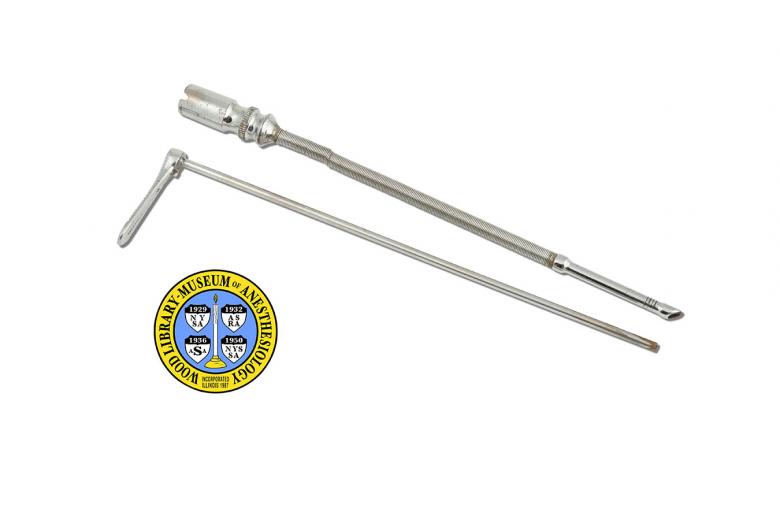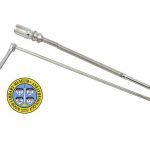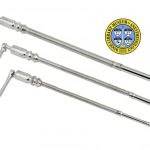Flagg Endotracheal Tube
Dr. Paluel J. Flagg (1886-1970) wrote one of the earliest American anesthesia textbooks in 1916. He also strove to improve patient safety through better understanding and management of the airway. Aided by Dr. Chevalier Jackson, he introduced his two-piece metal endotracheal tubes in 1928. These tubes are inserted into the patient's trachea (windpipe) to provide a clear passage for air and anesthetic gases both to and from the patient's lungs.
Reinforced tracheal tubes had been used as early as the 1870s. One of Dr. Flagg's innovations was to add a perfectly matched introducer, or stylet, to keep the flexible tube from kinking during insertion. Once the tube was in place, the rigid stylet was removed by pulling on the short handle. When in use, the spiral wire was covered with a rubber sheath to make it airtight. After use, this was discarded to allow the tubes to be sterilized. Illustrated here are Flagg tube sizes 3, 5, and 9.
Dr. Flagg’s strong interest in patient safety led him to found the Society for the Prevention of Asphyxial Death in 1933. For over 40 years, this organization taught doctors and paramedics how to perform basic and advanced respiratory and cardiac resuscitation.
Catalog Record: Flagg Endotracheal Tube
Catalog Records akng, akja, akiw
Access Key: akng
Accession No.: 2012-11-29-3 A & B
Title: [Flagg inhalation tube with 9 millimeter bronchoscopic tip / designed by
Paluel J. Flagg].
Author: Flagg, Paluel J. (Paluel Joseph), 1886-1970.
Title variation: Alt Title
Title: Flagg intratracheal inhalation tube with 9 millimeter tip.
Title variation: Alt Title
Title: Size 9 Flagg endotracheal tube.
Title variation: Alt Title
Title: Flexible metal catheter – Flagg 9.
Title variation: Alt Title
Title: Number 9 Flagg intratracheal catheter.
Publisher: [New York] : Foregger, [1927-1962].
Physical Descript: 1 endotracheal tube ; metal : 5.5 x 1.5 x 32.5 cm.
Subject: Anesthesia, Intratracheal – instrumentation.
Subject: Intubation, Intratracheal – instrumentation.
Subject: Flagg, Paluel J. (Paluel Joseph), 1886-1970.
Notes: Title constructed from the caption of an illustration in the 1928 book by Dr.
Flagg, “The Art of Anaesthesia”. The caption reads, “Fig. 135.—Flagg
intratracheal inhalation outfit. A, laryngoscope; B. flexible red
rubber-covered inhalation tube with 9 millimeter bronchoscopic tip; C,
inhalation tube with 7 millimeter tip; D, inhalation tube with 5 millimeter
tip; F, suction tube; G, ether reservoir, H, connecting tubing.”
Note Type: General
Notes: The early year (1927) in the date range for the possible year of manufacture
is based on the date in which Dr. Flagg first described his endotracheal tube
in a publication. When first produced the tube was available in three sizes,
5, 7, and 9. The late year is based on the last Foregger catalog, held by the
WLM, that includes the Flagg tube (1962). The date range could change if
documentation indicates the range should be corrected.
Note Type: Citation
Notes: Catalog 1935. New York: The Foregger Company; 1935:52.
Note Type: Citation
Notes: Catalog No. 7. New York: The Foregger Company; 1937:52.
Note Type: Citation
Notes: Flagg PJ. The Art of Anaesthesia. Philadelphia: J.B. Lippincott Company;
1928:371-375.
Note Type: Citation
Notes: Flagg PJ. Intratracheal inhalation: preliminary report of a simplified method
of intratracheal anesthesia developed under the supervision of Dr. Chevalier
Jackson. Arch Otoloarngol. 1927;5(5):394-399.
Note Type: Citation
Notes: Flagg PJ. A simplified method of intratracheal ether anesthesia. Anesth Analg
1929;8(6):327-332.
Note Type: Citation
Notes: Foregger: apparatus for anesthesia, oxygen, and extracorporeal circulation.
New York: The Foregger Company; 1960:55.
Note Type: Citation
Notes: Gillespie NA. Equipment and apparatus for intubation. In: Endotracheal
Anaesthesia. Wisconsin: University of Wisconsin Press; 1941:46-65.
Note Type: Citation
Notes: Hargrave R. Endotracheal anaesthesia in surgery of the head and neck.
Canadian Med Assoc J. June, 1934;30(6):633-637.
Note Type: Citation
Notes: Maltby JR. Flagg can: Paluel Joseph Flagg (1886-1790). In: Notable Names in
Anaesthesia. London: Royal Society of Medicine Press; 2002:66-68.
Note Type: Physical Description
Notes: A metal endotracheal tube with rigid metal stylet; Descriptions and
measurements based on patient perspective, i.e., tracheal tip is the proximal
end, and the connector end is the distal end.; With the stylet in place the
two pieces measure approximately 5.5 x 1.5 x 32.1; The body of the tube is
composed of a metal spiral, while the distal and proximal ends are tubular
metal; The length of the distal end is approximately 5.1 cm and the diameter
of the opening is approximately 1.5 cm; The length of the flexible body is
approximately 17.4 cm; The external diameter of the spiraled body of the
tube is about 1.1 cm; Approximately .3 of a cm of the proximal end of the
spiral is not as tightly wound as the rest of the body, as if stretched out
of its original shape; The proximal end, or “tracheal tip” measures
approximately 9 cm in length and has a beveled opening; The handle of the
stylet is stamped or engraved with, “FOREGGER”; When the stylet is removed,
the body of the endotracheal tube is quite flexible.
Note Type: Reproduction
Notes: Photographed by Mr. Steve Donisch on January 17, 2013.
Note Type: Historical
Notes: These endotracheal tubes are but one example of the wide range of devices
designed by Paluel J. Flagg (1886-1970) during in his career-long drive to
improve anesthesia care and resuscitation.
The inspiration for these tubes was described by Dr. Flagg in a 1927 article
in which he outlined what he saw as critical inadequacies with intratracheal
insufflation. He summarized advancements in intubation due largely to the
respected laryngologist Chevalier Jackson (1865-1958), and described the size
of Dr. Ivan Magill’s double lumen endotracheal tubes. Flagg suggested the use
of single lumen, large diameter endotracheal tubes through which both
inhalation and exhalation could effectively occur. He also reasoned that an
endotracheal tube of larger diameter could essentially block the drainage of
blood and gastric contents into the lungs, by virtue of the amount space the
tube occupied at the opening to the lungs. The paper also reviewed his work
with Dr. Jackson in determining the largest diameter of endotracheal tube
that may be left in place for periods of two or more hours without causing
injury. Flagg concluded his paper by enumerating six advantages provided by
the use of large-diameter endotracheal tubes.
Images and descriptions of the flexible metal endotracheal tubes that Dr.
Flagg designed where published in 1928 and 1929 along with some of the other
equipment he recommended for his methods of intubation and endotracheal
anesthesia. He chose a metal coil because he believed that rubber became too
easily compressed after repeated sterilizations, posing too great a risk for
airway occlusion. Because the metal coils were not airtight, before use, the
metal tube was covered with thin rubber drainage tubing. Flagg recommended
that the rubber be removed after use so that the tube could be thoroughly
sterilized. Every tube came with a straight metal stylet to aid placement
into the trachea.
Dr. Flagg developed this tube during a time when a number of other
anesthesiologists’ were also designing endotracheal tubes. Two of the better
known examples include the cuffed endotracheal tube introduced by Drs.
Aurther Guedel and Ralph Waters in 1928, and the ‘wide-bore’ tube of Dr. Ivan
Magill in 1928. Eventually, metal tubes fell out of use. However, Flagg’s
advocacy of endotracheal anesthesia played an important role in the
acceptance and expansion of its use during the 1940s and 1950s.
A few of Dr. Flagg’s other accomplishments include the design of a simple
ether vaporizer called the “Flagg Can”, a laryngoscope with a light bulb in
the blade and batteries in the handle, the authorship of a classic text, The
Art of Anaesthesia, and the foundation of the Society for the Prevention of
Asphyxial Death (SPAD). The SPAD was an organization that, for over 40 years,
taught doctors and paramedics how to perform basic and advanced respiratory
and cardiac resuscitation.
Note Type: Publication
Notes: Flagg JA. My First Forty Years in Anesthesia: as related by Dad.
[unpublished] 1951. Held by the WLM Archives (Paluel J. Flagg collection,
donated by James A. Flagg).
Note Type: Publication
Notes: Flagg PJ. Anesthesia: suggestion bearing upon its standardization for
teaching purposes. Am J Surg: Anesth Suppl. April, 1917;31(4 suppl):62-63.
Note Type: Publication
Notes: Flagg PJ. Anesthesia as an art [editorial]. Am J Surg. August,
1941;53(2):199-201.
Note Type: Publication
Notes: Flagg PJ. The Art of Resuscitation. New York: Reinhold Publishing
Corporation; 1944.
Note Type: Publication
Notes: Rosenberg H, Axelrod JK. The introduction and popularization of endotracheal
intubation into anesthesia practice. Bul Anesth Hist. October, 2003;21(4):1,
4-6.
Note Type: Publication
Notes: Waters RM, Rovenstine EA, Guedel AE. Endotracheal anesthesia and its
historical development. Anesth Analg. September, 1933;12(5):196-203.
Note Type: Exhibition
Notes: Chosen for the WLM website (noted September 6, 2013).
Access Key: akja
Accession No.: 2012-11-29-2 A & B
Title: [Flagg inhalation tube with 5 millimeter bronchoscopic tip / designed by
Paluel J. Flagg].
Author: Flagg, Paluel J. (Paluel Joseph), 1886-1970.
Title variation: Alt Title
Title: Flagg intratracheal inhalation tube with 5 millimeter tip.
Title variation: Alt Title
Title: Size 5 Flagg endotracheal tube.
Title variation: Alt Title
Title: Flexible metal catheter – Flagg 5.
Title variation: Alt Title
Title: Number 5 Flagg intratracheal catheter.
Publisher: [New York] : Foregger, [1927-1962].
Physical Descript: 1 endotracheal tube ; metal : 6 x 1.5 x 28 cm.
Subject: Intubation, Intratracheal – instrumentation.
Subject: Anesthesia, Intratracheal – instrumentation.
Subject: Flagg, Paluel J. (Paluel Joseph), 1886-1970.
Note Type: General
Notes: Title constructed from the caption of an illustration in the 1928 book by Dr.
Flagg, “The Art of Anaesthesia”. The caption reads, “Fig. 135.—Flagg
intratracheal inhalation outfit. A, laryngoscope; B. flexible red
rubber-covered inhalation tube with 9 millimeter bronchoscopic tip; C,
inhalation tube with 7 millimeter tip; D, inhalation tube with 5 millimeter
tip; F, suction tube; G, ether reservoir, H, connecting tubing.”
Note Type: General
Notes: The early year (1927) in the date range for the possible year of manufacture
is based on the date in which Dr. Flagg first described his endotracheal tube
in a publication. When first produced the tube was available in three sizes,
5, 7, and 9. The late year is based on the last Foregger catalog, held by the
WLM, that includes the Flagg tube (1962). The date range could change if
documentation indicates the range should be corrected.
Note Type: Citation
Notes: Catalog 1935. New York: The Foregger Company; 1935:52.
Note Type: Citation
Notes: Catalog No. 7. New York: The Foregger Company; 1937:52.
Note Type: Citation
Notes: Flagg PJ. The Art of Anaesthesia. Philadelphia: J.B. Lippincott Company;
1928:371-375.
Note Type: Citation
Notes: Flagg PJ. Intratracheal inhalation: preliminary report of a simplified method
of intratracheal anesthesia developed under the supervision of Dr. Chevalier
Jackson. Arch Otoloarngol. 1927;5(5):394-399.
Note Type: Citation
Notes: Flagg PJ. A simplified method of intratracheal ether anesthesia. Anesth Analg
1929;8(6):327-332.
Note Type: Citation
Notes: Foregger: apparatus for anesthesia, oxygen, and extracorporeal circulation.
New York: The Foregger Company; 1960:55.
Note Type: Citation
Notes: Gillespie NA. Equipment and apparatus for intubation. In: Endotracheal
Anaesthesia. Wisconsin: University of Wisconsin Press; 1941:46-65.
Note Type: Citation
Notes: Hargrave R. Endotracheal anaesthesia in surgery of the head and neck.
Canadian Med Assoc J. June, 1934;30(6):633-637.
Note Type: Citation
Notes: Maltby JR. Flagg can: Paluel Joseph Flagg (1886-1790). In: Notable Names in
Anaesthesia. London: Royal Society of Medicine Press; 2002:66-68.
Note Type: Physical Description
Notes: A metal endotracheal tube with rigid metal stylet; Descriptions and
measurements based on patient perspective, i.e., tracheal tip is the proximal
end, and the connector end is the distal end.; With the stylet in place the
two pieces measure approximately 5.7 x 1.5 x .27.8; The body of the tube is
composed of a metal spiral, while the distal and proximal ends are tubular
metal; The length of the distal end is approximately 5.2 cm and the diameter
of the opening is approximately 1.5 cm; The length of the flexible body is
approximately 16.8 cm; The external diameter of the spiraled body of the
tube measures approximately .8 cm; About .5 of a cm of the proximal end of
the spiral is not as tightly wound as the rest of the body, as if stretched
out of its original shape; The proximal end, or “tracheal tip” measures
approximately 5.1 cm in length and has a beveled opening; The handle of the
stylet is stamped or engraved with, “FOREGGER”; When the stylet is removed,
the body of the endotracheal tube is quite flexible.
Note Type: Reproduction
Notes: Photographed by Mr. Steve Donisch on January 17, 2013.
Note Type: Exhibition
Notes: Chosen for the WLM website (noted September 6, 2013).
Access Key: akiw
Accession No.: 2012-12-20-1 A & B
Title: [ Flagg inhalation tube with 3 millimeter bronchoscopic tip / designed by
Paluel J. Flagg].
Author: Flagg, Paluel J. (Paluel Joseph), 1886-1970.
Title variation: Alt Title
Title: Flagg intratracheal inhalation tube with 3 millimeter tip.
Title variation: Not Applicable
Title: Size 3 Flagg endotracheal tube.
Title variation: Alt Title
Title: Flexible metal catheter – Flagg 3.
Title variation: Alt Title
Title: Number 3 Flagg intratracheal catheter.
Publisher: [New York] : Foregger, [1936-1962].
Physical Descript: 1 endotracheal tube ; metal : 6 x 1.5 x 25.5 cm.
Subject: Intubation, Intratracheal – instrumentation.
Subject: Anesthesia, Intratracheal – instrumentation.
Subject: Flagg, Paluel J. (Paluel Joseph), 1886-1970.
Note Type: General
Notes: Title constructed from the caption of an illustration in the 1928 book by Dr.
Flagg, “The Art of Anaesthesia”. The caption reads, “Fig. 135.—Flagg
intratracheal inhalation outfit. A, laryngoscope; B. flexible red
rubber-covered inhalation tube with 9 millimeter bronchoscopic tip; C,
inhalation tube with 7 millimeter tip; D, inhalation tube with 5 millimeter
tip; F, suction tube; G, ether reservoir, H, connecting tubing.”
Note Type: General
Notes: Although the article in which Dr. Flagg first discussed his endotracheal tube
was published in 1927, the number 3 sized tubes were not manufactured by
Foregger until after 1935. The early year in the date range for the possible
year of manufacture is based on the date of the 1935 Foregger catalog that
does not include a size 3 tube. The 1937 catalog does include a size 3 tube.
The late year is based on the last Foregger catalog, held by the WLM, that
includes the Flagg tube (1962). The date range could change if documentation
indicates the range should be corrected.
Note Type: Citation
Notes: Catalog 1935. New York: The Foregger Company; 1935:52.
Note Type: Citation
Notes: Catalog No. 7. New York: The Foregger Company; 1937:52.
Note Type: Citation
Notes: Flagg PJ. The Art of Anaesthesia. Philadelphia: J.B. Lippincott Company;
1928:371-375.
Note Type: Citation
Notes: Flagg PJ. Intratracheal inhalation: preliminary report of a simplified method
of intratracheal anesthesia developed under the supervision of Dr. Chevalier
Jackson. Arch Otoloarngol. 1927;5(5):394-399.
Note Type: Citation
Notes: Flagg PJ. A simplified method of intratracheal ether anesthesia. Anesth Analg
1929;8(6):327-332.
Note Type: Citation
Notes: Foregger: apparatus for anesthesia, oxygen, and extracorporeal circulation.
New York: The Foregger Company; 1960:55.
Note Type: Citation
Notes: Gillespie NA. Equipment and apparatus for intubation. In: Endotracheal
Anaesthesia. Wisconsin: University of Wisconsin Press; 1941:46-65.
Note Type: Citation
Notes: Hargrave R. Endotracheal anaesthesia in surgery of the head and neck.
Canadian Med Assoc J. June, 1934;30(6):633-637.
Note Type: Citation
Notes: Maltby JR. Flagg can: Paluel Joseph Flagg (1886-1790). In: Notable Names in
Anaesthesia. London: Royal Society of Medicine Press; 2002:66-68.
Note Type: Physical Description
Notes: A metal endotracheal tube with rigid metal stylet; Descriptions and
measurements based on patient perspective, i.e., tracheal tip is the proximal
end, and the connector end is the distal end.; With the stylet in place the
two measure approximately 5.7 x 1.5 x 25.2; The body of the tube is composed
of a metal spiral, while the distal and proximal ends are tubular metal; The
external diameter of the spiraled body of the tube measures about .7 cm; The
length of the distal end is approximately 4.7 cm and the diameter of the
opening is approximately 1.5 cm; The length of the flexible body is
approximately 14 cm; The proximal end, or “tracheal tip” measures
approximately 6 cm in length and has a beveled opening; The handle of the
stylet is stamped or engraved with, “FOREGGER”; When the stylet is removed
the body of the endotracheal tube is quite flexible.
Note Type: Reproduction
Notes: Photographed by Mr. Steve Donisch on January 17, 2013.



